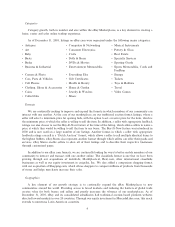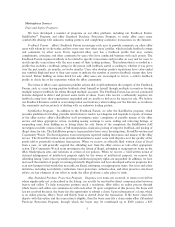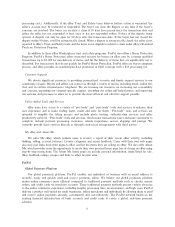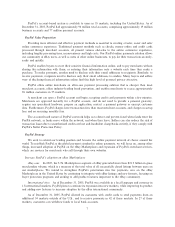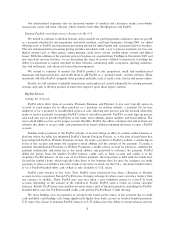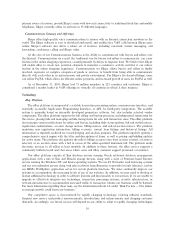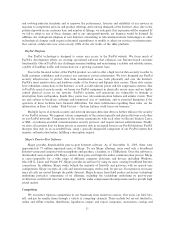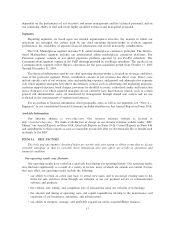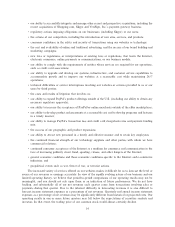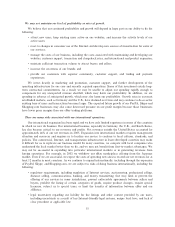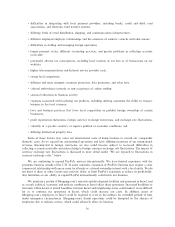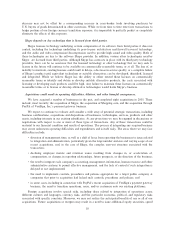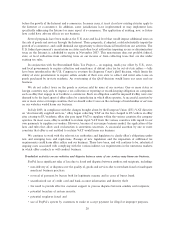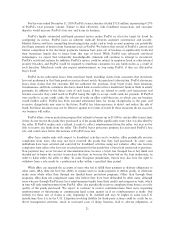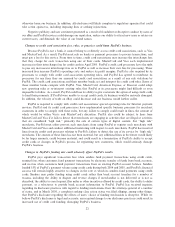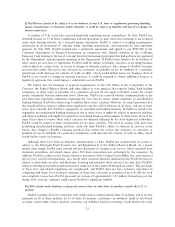eBay 2005 Annual Report Download - page 18
Download and view the complete annual report
Please find page 18 of the 2005 eBay annual report below. You can navigate through the pages in the report by either clicking on the pages listed below, or by using the keyword search tool below to find specific information within the annual report.‚ our ability to successfully integrate and manage other recent and prospective acquisitions, including the
recent acquisitions of Shopping.com, Skype and VeriSign, Inc.'s payment gateway business;
‚ regulatory actions imposing obligations on our businesses (including Skype) or our users;
‚ the actions of our competitors, including the introduction of new sites, services, and products;
‚ consumer confidence in the safety and security of transactions using our websites or technology;
‚ the cost and availability of online and traditional advertising, and the success of our brand building and
marketing campaigns;
‚ new laws or regulations, or interpretations of existing laws or regulations, that harm the Internet,
electronic commerce, online payments or communications, or our business models;
‚ our ability to comply with the requirements of entities whose services are required for our operations,
such as credit card associations;
‚ our ability to upgrade and develop our systems, infrastructure, and customer service capabilities to
accommodate growth and to improve our websites at a reasonable cost while maintaining 24/7
operations;
‚ technical difficulties or service interruptions involving our websites or services provided to us or our
users by third parties;
‚ the costs and results of litigation that involves us;
‚ our ability to expand PayPal's product offerings outside of the U.S. (including our ability to obtain any
necessary regulatory approvals);
‚ our ability to increase the acceptance of PayPal by online merchants outside of the eBay marketplaces;
‚ our ability to develop product enhancements at a reasonable cost and to develop programs and features
in a timely manner;
‚ our ability to manage PayPal's transaction loss and credit card chargeback rates and payment funding
mix;
‚ the success of our geographic and product expansions;
‚ our ability to attract new personnel in a timely and effective manner and to retain key employees;
‚ the continued financial strength of our technology suppliers and other parties with whom we have
commercial relations;
‚ continued consumer acceptance of the Internet as a medium for commerce and communication in the
face of increasing publicity about fraud, spoofing, viruses, and other dangers of the Internet;
‚ general economic conditions and those economic conditions specific to the Internet and e-commerce
industries; and
‚ geopolitical events such as war, threat of war, or terrorist actions.
The increased variety of services offered on our websites makes it difficult for us to forecast the level or
source of our revenues or earnings accurately. In view of the rapidly evolving nature of our business and our
limited operating history, we believe that period-to-period comparisons of our operating results may not be
meaningful, and you should not rely upon them as an indication of future performance. We do not have
backlog, and substantially all of our net revenues each quarter come from transactions involving sales or
payments during that quarter. Due to the inherent difficulty in forecasting revenues it is also difficult to
forecast income statement expenses as a percentage of net revenues. Quarterly and annual income statement
expenses as a percentage of net revenues may be significantly different from historical or projected rates. Our
operating results in one or more future quarters may fall below the expectations of securities analysts and
investors. In that event, the trading price of our common stock would almost certainly decline.
14


